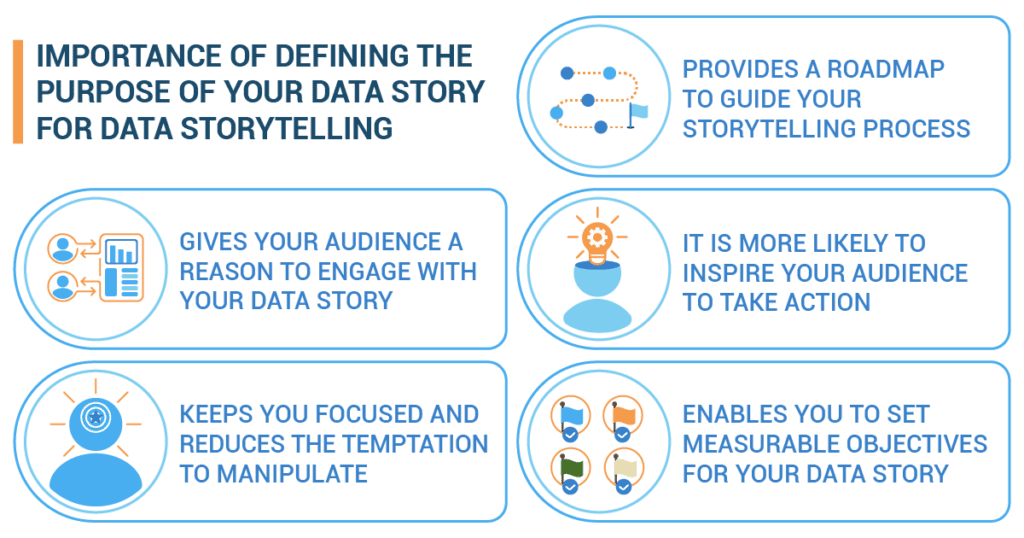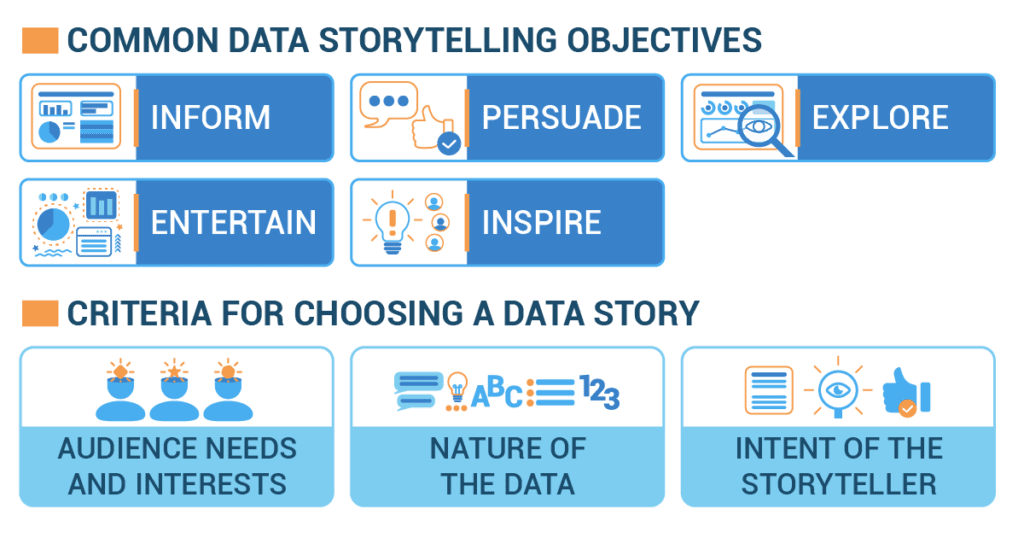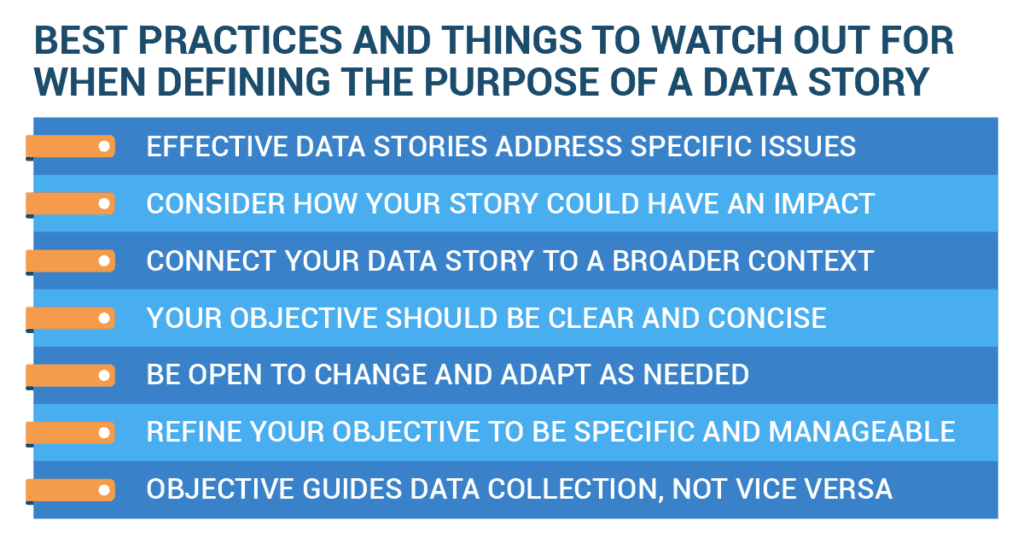Let’s start with a little scenario, something that might sound quite familiar. Imagine it’s Saturday morning. You walk down to your favorite coffee shop, greeted by the tantalizing aroma of freshly brewed coffee. You order your usual, and while waiting, you mindlessly pull out your phone and scroll through social media. Your feed is packed with posts – photos, updates, news stories – it’s a data overload. And yet, you swiftly glide through it all, effortlessly, sorting out the significant from the insignificant. But how exactly do you do this? How do you decide which post to pause at and which story to dive into?
The answer lies in purpose – the ‘why’ behind each story.
Every day, consciously or not, we’re all sifting through a vast ocean of stories – of data. But not all of it engages us, not all of it sticks. The ones that do, they have something in common – a compelling purpose that resonates with us.
And that is precisely what we’re here to delve into – the idea of ‘Purpose in Data Storytelling.’ It’s not some abstract, high-concept topic. It’s something you all do, every day, probably without realizing it. You are all data storytellers, and today, we’re going to explore the purpose behind the stories you tell, you read, and most importantly, you engage with.
The Purpose of a Data Story
Defining the purpose of your data story provides a roadmap to guide your storytelling process. This helps you make decisions about what data to include, what questions to answer, and how to structure your narrative.
- Think of yourself as a detective, and you’ve just walked into a room filled with clues. To solve the case, you need to sort through the clues and find the ones that help you tell the story of what happened. It’s similar with data storytelling. We can think of each piece of data as a clue to the bigger story we want to tell. The purpose of your data story is like the mystery you’re trying to solve. It guides which clues you pay attention to and how you put them together to solve the case.
By having a clear purpose, you give your audience a reason to engage with your data story. This purpose connects with their interests or needs and motivates them to pay attention and remember your message.
- Imagine trying to solve a mystery without knowing what mystery you’re trying to solve. It would be pretty hard, right? The same goes for data storytelling. Without a clear purpose, you won’t know which data is important or how to structure your story. It’s like trying to put together a puzzle without seeing the picture on the box.
When your data story has a clear purpose, it is more likely to inspire your audience to take action. This could range from making a decision, changing a behavior, or simply thinking about an issue in a new way.
- Let’s say you’re giving a presentation about how much time employees at your company spend on doing presentations each night. If your purpose is just to share some facts, that might not be very exciting. But, if your purpose is to show that employees are spending too much time on work and not enough time on other important things like exercise or sleep, that’s a story your officemates might be more interested in.
A defined purpose keeps you focused and reduces the temptation to manipulate or misinterpret the data to make it more interesting or compelling.
- Suppose you are conducting a research project to investigate the relationship between employees’ sleep patterns and their satisfaction ratings. A defined purpose would ensure that you analyze the data objectively, accurately representing the relationship between sleep patterns and performance.
With a clear purpose, you can set measurable objectives for your data story. This allows you to evaluate whether your story has been successful in achieving its intended goal.
- You are involved in analyzing employee performance data and proposing strategies for improving ratings. Once you have completed your data story, you can evaluate whether your objectives have been met. If the measurable goals have been achieved or exceeded, it indicates a successful data story that has effectively highlighted the impact of personalized programs on employee satisfaction ratings.
Choosing an Objective for Your Data Story
- Inform: Consider that you’ve recently conducted a survey within your company to determine the most preferred project management methodologies among employees. Your objective could be to inform your colleagues about the prevalent project management approaches. This objective focuses on sharing factual information without seeking any specific action or response. The accuracy, relevance, and comprehensiveness of your data are crucial to presenting a comprehensive view of the topic.
- Persuade: Now, envision a scenario where you’re advocating for the adoption of a new software system in your company’s IT department. You might use data showcasing the efficiency gains and cost savings associated with the new system to persuade the management to make the switch. The aim here is to influence the decision-making process and guide your audience towards a particular viewpoint. Your data must strongly support your argument and resonate with your audience’s logical reasoning and values.
- Explore: Imagine you’re tasked with analyzing employee engagement levels across various departments in your company. You could create an interactive dashboard where leaders can explore the data and draw their own insights. This approach encourages your audience to engage with the data and draw conclusions tailored to their specific interests. Interactive data visualization is suitable when you have a rich dataset that facilitates in-depth analysis, and your audience is inclined toward exploring complex patterns.
- Entertain: Suppose you’ve gathered data on workplace habits that boost productivity, but you want to present it in a light-hearted and engaging manner. Your objective could be to entertain your colleagues with amusing and surprising insights. By incorporating fun facts and visually appealing charts, you can engage your audience and infuse an element of enjoyment into your data presentation. This objective is ideal when your data lends itself to intriguing or visually captivating representations.
- Inspire: Picture a scenario where you’re advocating for the adoption of sustainable practices within your company, such as reducing paper consumption. You could leverage data illustrating the positive environmental impact of such practices to inspire your colleagues to make eco-friendly choices. The goal here is to motivate your audience to take specific actions aligned with their values. Your data should clearly demonstrate the benefits of the desired action and appeal to your audience’s sense of responsibility and desire for positive change.
When Choosing Your Objective, Think About the Following:
- Audience needs and interests: Who is the story for? What are their needs, interests, and level of knowledge about the subject?
- Nature of the data: What kind of data do you have, and what does it tell you?
- Intent of the storyteller: Why are you telling this story? Is it to inform, persuade, encourage exploration, or explain something?
Best Practices and Tips for Defining Your Purpose
- Try to solve a problem: Think of your purpose as the mystery you’re trying to solve. This could be a real-world problem like, “How can we reduce food waste in our school?”
- Keep it simple: If your purpose is too complex, you might lose your audience. Make sure it’s something easy to understand.
- Be open to change: As you dig into your data, you might find that your purpose needs to change. That’s okay!
- Be specific: Don’t try to cover too much in one story. Focus on one specific topic.
- Let your purpose guide you: Once you have a purpose, let it guide your data collection. You might find that you need more data to tell your story.
Crafting a Data Story for Mobile Phone Innovation
In the ever-evolving landscape of technology, “TechWave” was a prominent company known for its groundbreaking advancements in mobile phone innovation. The company’s Senior Product Manager, Emily Parker, found herself at a crossroads of data and innovation – a juncture where data storytelling had the potential to reshape their approach to product development. Emily recognized that the purpose of their data story went beyond numbers; it was about guiding the trajectory of their mobile phone offerings.
Emily was a seasoned product manager with a knack for blending market trends with creative flair. The challenge she faced was not just about designing cutting-edge mobile phones; it was about understanding the pulse of consumer preferences and anticipating future demands. She understood that the data story they crafted needed to act as a compass for their product strategy. TechWave’s latest mobile phone release was on the horizon, and Emily aimed to uncover the key features that would resonate most with their target audience. The purpose of their data story was to identify the ideal mix of specifications and functionalities that would set their upcoming mobile phone apart from competitors. In a brainstorming session with her product development team, Emily emphasized that the data story wasn’t just about presenting information; it was about synthesizing data-driven insights to inspire innovation. The data points were like puzzle pieces, each contributing to a larger picture that illuminated the path forward.
Emily and her team embarked on an extensive data collection journey. They analyzed customer feedback, market trends, and user behavior patterns. Their goal was to piece together a narrative that depicted not just what customers wanted now, but also what they might desire in the future. As the data was analyzed, patterns emerged. Emily’s team noted a growing preference for enhanced camera capabilities and longer battery life among users. They also observed a shift towards environmentally conscious features, indicative of a broader trend in sustainable technology. Armed with these insights, Emily and her team wove a data story that presented a clear narrative of their mobile phone’s journey. The data-backed features aligned with market trends and anticipated future needs, showcasing TechWave’s commitment to innovation and customer-centricity.
The data story served as a guiding light for product development. Emily’s team incorporated the insights into the design process, ensuring that the upcoming mobile phone not only met the current expectations but also exceeded them. As TechWave unveiled the new mobile phone, they witnessed an enthusiastic response from consumers. The data-inspired features resonated strongly with customers, positioning the product as a frontrunner in mobile phone innovation.
Conclusion:
In the dynamic world of technology, TechWave demonstrated the profound impact of a purpose-driven data story. Emily Parker’s understanding of the story’s purpose allowed her to guide innovation and product development with a data-backed vision. By infusing insights into the narrative, corporate professionals like Emily steered their companies toward market leadership, ensuring that their offerings were not just relevant but visionary, propelling the evolution of mobile phone technology to new heights.


